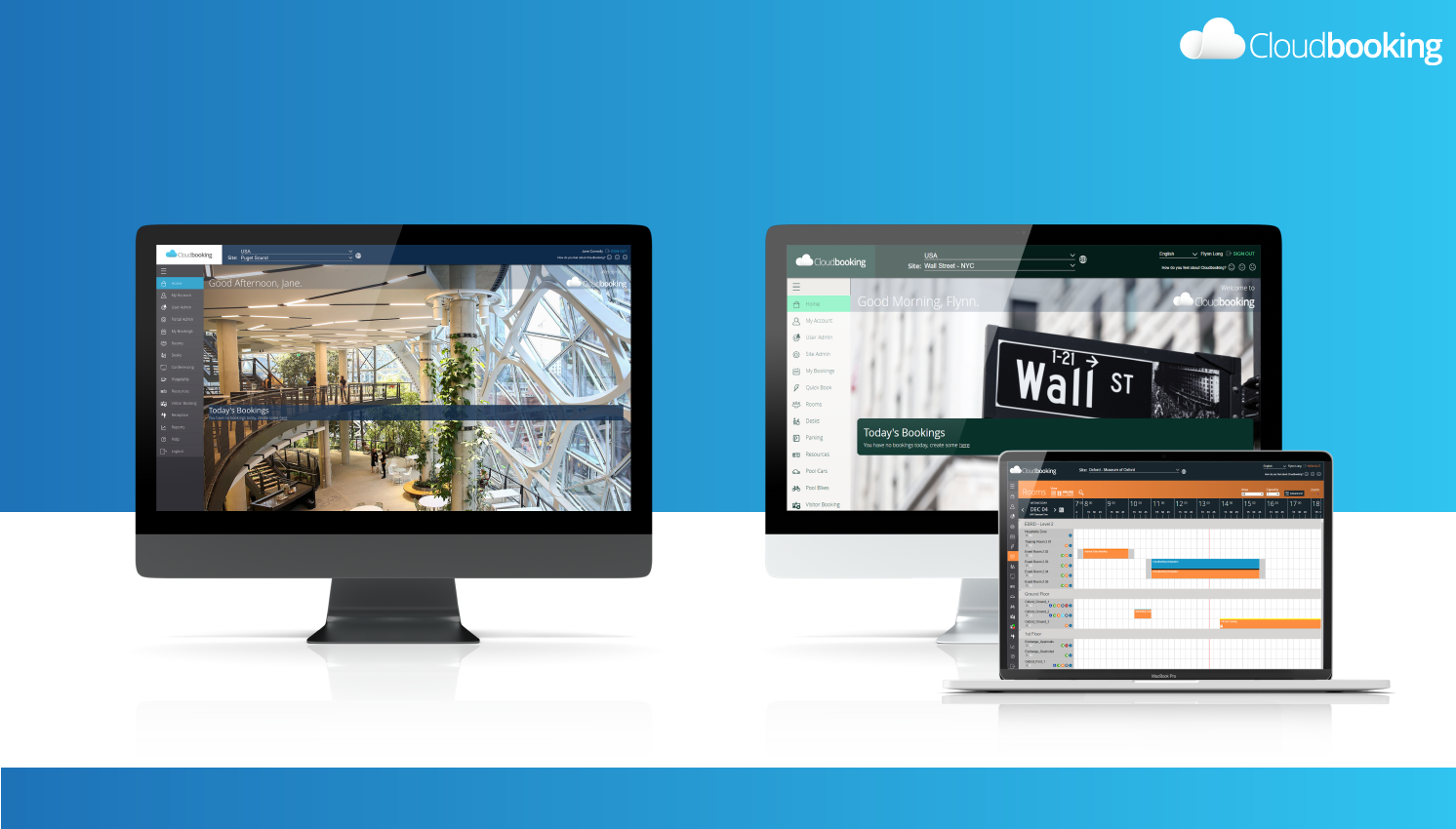
There is increasing awareness around environmental degradation and sustainability. Our impact, as humans, on the environment is bringing detrimental consequences, which will only worsen if collective action is not taken.
Get a free demo
Enquire about a no-obligation demo today and get an exclusive hybrid working research paper — for free. Created in partnership with YouGov, this invaluable guide provides essential insights into developing your own effective hybrid strategy. Click below.
Organizations play a significant part in the process of reducing our carbon emissions and can even be seen as role models for individuals in this area. There are many benefits to reducing your carbon footprint at the smart office. This post will consider these and cover ten ways you can make a positive difference in this area.
For more specific information about how Cloudbooking’s Workspace Management solutions for Government organisations can help improve sustainability and efficiency, please visit our specific government industry solution page, otherwise let’s get started!
Why should you reduce carbon emissions in the workplace?
There is a growing awareness about how we, as humans, are causing significant and long-term environmental degradation through our choices, actions, and lifestyles. As we become increasingly aware of this, governments, government organisations, businesses and individuals are all looking for ways to reduce man-made pollution and carbon emissions.
This is a global problem that must be tackled at all levels by governments, businesses, and individuals if we are to reduce our impact on the environment and reverse the negative trends. There are several reasons why organizations should look to incorporate sustainability into their identities and everyday practices.
First, there is the apparent reason that it is an inherent good. We all live and rely on the planet and its resources. We, therefore, all have a stake in preserving the environment for our benefit and for the benefit of future generations.
Another reason is that consumers are increasingly demanding that businesses take greater responsibility for their impact on the environment. By showing consumers that you take sustainability seriously, you can attract more customers and promote brand loyalty.
Furthermore, reducing your organization’s carbon footprint is an excellent way to cut operational costs. It just makes good business sense. When you measure your carbon footprint and take action in all areas to reduce it, the strong likelihood is that you will notice substantial cost-efficient outcomes while eliminating unnecessary expenditure.
Finally, because carbon reduction initiatives are inherently dependent on the newest technologies and contemporary ideas, you will naturally be future-proofing your workplace by taking action within this area.
1. Reduce physical workspace
The more physical space you have available to operate within, the more energy is required to run your business. By reducing your physical office space, you can save on utilities such as electricity, heating, and water. Organizations are moving away from traditional working practices, where employees must be in the same physical space five days a week during standard office hours.
You can reduce the amount of physical space you need by simply switching to a hybrid working environment. This involves a combination of remote working and in-office working. Encourage people to work from home where independent working is required. Redesign your office space to accommodate collaboration spaces for teamwork and meetings.
2. Use technology to support remote collaboration
To ensure your workforce can operate effectively on a hybrid working model, you must implement the appropriate technologies. Comprehensive cloud-based systems can allow for effective communication and collaboration wherever your employees are located. Identify your needs and find solutions that meet these, supporting document sharing and storage as well as user-friendly tools for collaboration and communication.
3. Go paperless
We no longer need to print documents the way we used to due to cloud technologies that support document sharing and storage. Yet some companies, and their employees, have not broken the habit of excessive printing, which is an unnecessary use of energy and resources.
By encouraging a paperless culture supported by the appropriate technologies, you can significantly reduce your carbon emissions in the workplace. In addition, you will reduce costs while increasing efficiency and security. Digital document storage also goes hand in hand with physical space reduction as you will need fewer printers and fewer physical document storage solutions.
4. Use smart technologies to reduce utilities
The Internet of Things (IoT) is becoming the norm in our personal lives and at work. An increasing number of businesses are investing in smart office solutions to manage operational processes while reducing costs and carbon emissions.
Smart technologies can manage aspects of your physical space, such as lighting and climate control. Implement these technologies to automatically turn off lighting and heating in spaces that are not being utilized.
5. Recycle
Make it easy for employees to recycle in your workspace and encourage this practice. Make sure you have plenty of recycling bins available, which are easily accessible for all. Don’t assume that individuals know how to sort their waste or what is recyclable and what isn’t. Provide clear instructions for waste sorting and recycling.
Continuously reinforce the importance of recycling in your workplace. Not only will this help to make for a greener workspace, but it will also have the knock-on effect of normalizing the practice of recycling amongst individuals in their everyday lives. In this sense, your policies and procedures around sustainability will effectively have a positive ripple effect throughout society.
6. Reimagine business travel
Travel generates significant carbon emissions. If you are serious about reducing your carbon footprint in the workplace, you must reimagine all aspects of travel associated with work. Encouraging and facilitating remote working is one aspect of this. When fewer people need to travel to the office, travel requirements and emissions are reduced.
Where it is necessary for individuals to travel to the office, encourage carpooling, the use of public transport or greener ways of travelling such as walking or cycling. Perhaps consider supporting a cycle to work scheme or subsidizing public transportation for employees as an incentive.
7. Reduce waste
As well as recycling and going paperless wherever possible, look to all the ways you can reduce waste within your organization. Encourage reusable bottles, cups, and other food storage products. Consider how you can reduce food waste because this is a significant contributor to carbon emissions. When food is wasted, so are the energy and resources used in its growth, production, packaging, and transportation. In addition, rotting food produces greenhouse gases such as methane.
If your workspace has a cafeteria, make food waste reduction a top priority. Where food waste is an issue, consider participating in programs that support composting, food donation, or the use of food waste for animal feed and other products.
8. Conserve heat and energy
Vast amounts of energy are used by companies to light, heat, cool, and power their workspaces. Keep your emissions in this area to a minimum by optimizing energy efficiency. Use natural light wherever possible, invest in energy-efficient buildings and support renewable energies rather than fossil fuels.
Again, reducing physical office space can help with this, along with the introduction of smart technologies to manage your workspace utilities. Simply turning the thermostat down a few degrees can significantly reduce cost and emissions over time.
9. Invest in energy-efficient hardware and appliances
When investing in new hardware and appliances, ensure you source the most energy-efficient options. Appliances come with energy ratings, so assess and compare these before purchasing. Whether purchasing small or large appliances for your office, always choose the most energy-efficient options as this will add up to considerable reductions in emissions and energy use over time. Not only will this help the environment, but it will also result in cost savings for your business.
10. Build information systems for intelligent space management
Technology can play a huge part in helping us to manage our workspaces in an environmentally friendly way. Look to build information systems for intelligent space management. Where you have introduced hybrid working practices and smart appliances, technology can support the effective management of these.
Build systems that gather and analyze data relating to space utilization. This will help inform decision-making related to greener office policies and practices. Smart systems can also help by directly controlling certain aspects of the office environment, such as lighting and heating.
Workspace management systems, such as Cloudbooking’s, can help you control space usage in your office, enabling you to shut down spaces that are not being used. With all the relevant information available at a glance, you can make quick and efficient decisions to reduce energy usage in the workplace.
As an organization, your choices and practices matter. Not only can you substantially reduce your carbon footprint by following the tips laid out in this article but, by making sustainability a top priority, you will also be acting as a positive role model to individuals in their everyday lives. Begin by measuring your current carbon footprint, and then consider how you can start to reduce this. Look to technology to support sustainable practices in the workspace long-term.
Let us help you to create a sustainable office environment with our workspace management technologies. Contact us now for a no-obligation product demo.


